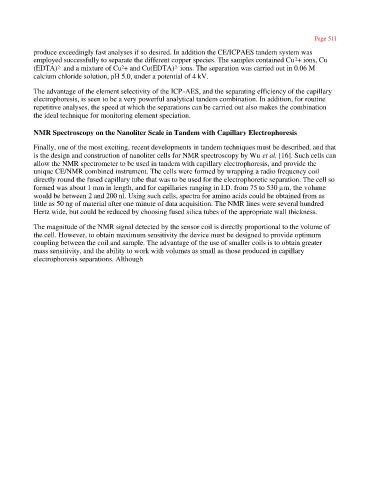Page 525 - Tandem Techniques
P. 525
Page 511
produce exceedingly fast analyses if so desired. In addition the CE/ICPAES tandem system was
employed successfully to separate the different copper species. The samples contained Cu + ions, Cu
2
(EDTA) and a mixture of Cu + and Cu(EDTA) ions. The separation was carried out in 0.06 M
2
2-
2-
calcium chloride solution, pH 5.0, under a potential of 4 kV.
The advantage of the element selectivity of the ICP-AES, and the separating efficiency of the capillary
electrophoresis, is seen to be a very powerful analytical tandem combination. In addition, for routine
repetitive analyses, the speed at which the separations can be carried out also makes the combination
the ideal technique for monitoring element speciation.
NMR Spectroscopy on the Nanoliter Scale in Tandem with Capillary Electrophoresis
Finally, one of the most exciting, recent developments in tandem techniques must be described, and that
is the design and construction of nanoliter cells for NMR spectroscopy by Wu et al. [16]. Such cells can
allow the NMR spectrometer to be used in tandem with capillary electrophoresis, and provide the
unique CE/NMR combined instrument. The cells were formed by wrapping a radio frequency coil
directly round the fused capillary tube that was to be used for the electrophoretic separation. The cell so
formed was about 1 mm in length, and for capillaries ranging in I.D. from 75 to 530 µm, the volume
would be between 2 and 200 nl. Using such cells, spectra for amino acids could be obtained from as
little as 50 ng of material after one minute of data acquisition. The NMR lines were several hundred
Hertz wide, but could be reduced by choosing fused silica tubes of the appropriate wall thickness.
The magnitude of the NMR signal detected by the sensor coil is directly proportional to the volume of
the cell. However, to obtain maximum sensitivity the device must be designed to provide optimum
coupling between the coil and sample. The advantage of the use of smaller coils is to obtain greater
mass sensitivity, and the ability to work with volumes as small as those produced in capillary
electrophoresis separations. Although

